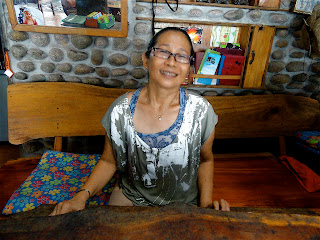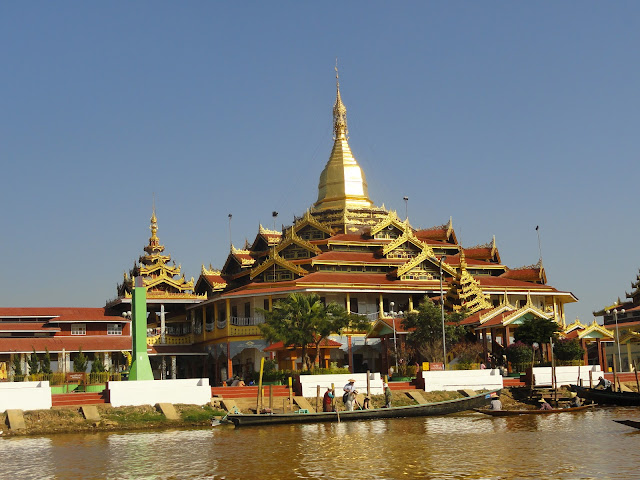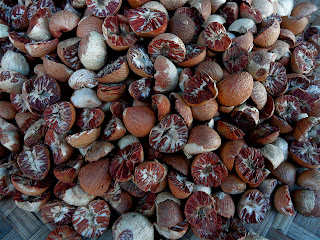Three weeks away from emails and cell phones! Who could ask for anything more? Not many English speaking travelers and only mosquitoes to contend with at the happy hour. Yes, around 5 PM they would arrive to chew on me on parts of my body that I couldn't reach to scratch.
This is probably the last blog entry from Thailand for this trip. I have some photos of the wonderful Thai markets to post but I don't know if I will make that happen. I am heading home as I write and edit these photos of Koh Chang. The island is a wonderful way to end a five month stay in Thailand. There is almost nothing to do. So for those travelers that need a lot of activities to make their vacation a success this is not the place to venture to on holiday. I read for hours in my hammock and never got bored.
This picture tells just about all. Probably extremely egotistical to start a blog with a self portrait, but it is really how I spent my time. In a hammock that I bought in Ranong knowing full well, ahead of time, of the comfort I was anticipating.
The island is a small island located in the Andaman Sea, very close to Burma off shore from the town/city of Ranong, Thailand. It is not the larger Koh Chang that is over off the east coast and heavily populated with tourists. That is the destination that travel agents and tour books will direct you to when you ask or go to look up travel information.

My bungalow was the closest one to the ocean, about 21 feet from the sand and depending on the tide how far I had to go to get wet. The water was always warm, much warmer that I am used to at home in my pool. A small room with a private bath with a cold shower, no screens, a mosquito net to sleep under and a small porch to spend my leisurely day practicing being a beach bum.

The island is very much a jungle of various tropical plants. Growing in the wild all of the bread fruits plus the cashew nut that the resort that I stayed in is named after. Cashew Resort is the largest of the 15+ resorts on the island with 45 bungalows all spread out from each other.
I was lucky to have a bungalow pet, roommate or guest. Either way you choose to look at this gecko he/she served a great purpose of aggressively eating all the unwanted visitors that visited my territory. Usually leaving behind at 10 AM every morning the evidence of his previous night's meal. The gecko was about a foot long and moved sporadically but with speed across the rafters and tiles. Amazingly it managed to intensify the color of the spotted pattern depending on how close I came to it.
This is the bungalow of the resort's one year-round resident. It fulfills my image of a beach bum's sprawling life style. The season for the island runs from late November until mid April when most of the resorts close up and stop taking guests. I understand a few will extend their operation but most pack up and head back to the mainland.


The long tail boats are the only way to reach the island from Ranong. As you can see the boats pull up to the beach and passengers use an awkward ladder to get aboard after wading through the surf. There are about 3 departures and arrivals during the day through the high season. It takes approximately one and a half hours to make the trip.

Besides the visitors to the island every thing that is used by the resorts -- food, ice, gas, fuel, furniture and all the various building supplies are transported to the specific resort that has placed an order. In this photo besides the passengers that have been off loaded the food stuffs and shelving that are on the beach have just been unloaded from the boat, yes, through the water.

The rubber tree plantation that is in the center of the island. I have never seen this kind of operation and figure that it must be very labor intensive. They use a half of a coconut shell to collect the white sap that runs off a diagonal cut in the bark of the tree, as seen in the picture below.
 The great surprise and added bonus in coming to the island this year was being able to continue practicing yoga every morning at Om Tao yoga center just 5 minutes from my bungalow. What a gift to be taking yoga in the natural setting of the jungle with all the sounds of the wild life and the breaking of the waves out on the beach, and the attacks of mosquitoes!!!
The great surprise and added bonus in coming to the island this year was being able to continue practicing yoga every morning at Om Tao yoga center just 5 minutes from my bungalow. What a gift to be taking yoga in the natural setting of the jungle with all the sounds of the wild life and the breaking of the waves out on the beach, and the attacks of mosquitoes!!!
And then there was meeting the yoga instructor. What would you expect if you were in my shoes, on an island, in a jungle setting and having no expectations? Would you expect to find Andrea?  What a wonderful person to meet on a remote island. Most of you know that I have been doing yoga for quite a while and when I am up in Chiang Mai I take 2 classes a day with Remco. He has really kept this old body functioning and I have the utmost love and respect for him. He just isn't the tall beautiful woman that Andrea is and I hope this doesn't offend him. Andrea got me to look at my old excuses/stories and go beyond the yoga practice that I had in the past. I can now do things I was planning to do in my next life. Thanks to this persistent, encouraging teacher.
What a wonderful person to meet on a remote island. Most of you know that I have been doing yoga for quite a while and when I am up in Chiang Mai I take 2 classes a day with Remco. He has really kept this old body functioning and I have the utmost love and respect for him. He just isn't the tall beautiful woman that Andrea is and I hope this doesn't offend him. Andrea got me to look at my old excuses/stories and go beyond the yoga practice that I had in the past. I can now do things I was planning to do in my next life. Thanks to this persistent, encouraging teacher.
 What a wonderful person to meet on a remote island. Most of you know that I have been doing yoga for quite a while and when I am up in Chiang Mai I take 2 classes a day with Remco. He has really kept this old body functioning and I have the utmost love and respect for him. He just isn't the tall beautiful woman that Andrea is and I hope this doesn't offend him. Andrea got me to look at my old excuses/stories and go beyond the yoga practice that I had in the past. I can now do things I was planning to do in my next life. Thanks to this persistent, encouraging teacher.
What a wonderful person to meet on a remote island. Most of you know that I have been doing yoga for quite a while and when I am up in Chiang Mai I take 2 classes a day with Remco. He has really kept this old body functioning and I have the utmost love and respect for him. He just isn't the tall beautiful woman that Andrea is and I hope this doesn't offend him. Andrea got me to look at my old excuses/stories and go beyond the yoga practice that I had in the past. I can now do things I was planning to do in my next life. Thanks to this persistent, encouraging teacher.
Although Koh Chang was not hit directly by the Tsunami of 2004 as was the rest of southern Thailand, some of the best signs to be found on the island are the warning signs directing people to the high ground. The island has mountains and rolling hills, so it is possible to get away from the approaching water and to safety.



Be prepared for sunsets as you have never experienced before. Nightly entertainment after being chewed on by the mosquitoes the quiet sunsets would develop for endless relaxing, no charge delight.


Island dogs become pets to families and visitors to the island. I don't know if there is a specific name for the breed, other than Island Ridgeback. They are all about the same size, black on top and tan on the underside, un-neutered, independent and free to roam the island. I never could keep them straight unless they had a colored collar. Breeding was a very popular activity or sport. Once they identified you as a potential caretaker you had at least one body that would be sorry to see you leave the island. And Lena Merna had two sad animals on her departure.

 Afternoon hikers seem casual but most of the time there is a motive behind the direction that they are going. Mother and daughter, Andrea and Lena are off to Crocodile Rock Resort for a great extended lunch that will include a swim at the rock itself. For the life of me, I never could see the crocodile in the rock or swimming in the water looking for lunch.
Afternoon hikers seem casual but most of the time there is a motive behind the direction that they are going. Mother and daughter, Andrea and Lena are off to Crocodile Rock Resort for a great extended lunch that will include a swim at the rock itself. For the life of me, I never could see the crocodile in the rock or swimming in the water looking for lunch.
Lek, the proprietor of the "Sunset Bungalows," with her fine menu and especially her homemade yogurt on top of a fruit bowl for breakfast made a very convincing argument to explore more of her resort. The sizable bungalows are spread out in the jungle among the well maintained gardens and pathways leading down to the restaurant and the water.

 In all likelihood, this is the last blog entry for this year's trip (2011-12) to Thailand. It has been a wonderful trip as those of you who have been following my entries can see, and to say I am looking forward to returning home would not be telling the total truth. To live in a relaxing, calm and gentle culture without the invasion of the media to disrupt my day and return to a culture that has given in to spending beyond its means is not where I am in my life. High tech living is what is happening and I know I will have to live with it, but... I know a place where I can hang my hammock, turn off my cell phone and where wireless can't reach me and sunsets are never the same.
In all likelihood, this is the last blog entry for this year's trip (2011-12) to Thailand. It has been a wonderful trip as those of you who have been following my entries can see, and to say I am looking forward to returning home would not be telling the total truth. To live in a relaxing, calm and gentle culture without the invasion of the media to disrupt my day and return to a culture that has given in to spending beyond its means is not where I am in my life. High tech living is what is happening and I know I will have to live with it, but... I know a place where I can hang my hammock, turn off my cell phone and where wireless can't reach me and sunsets are never the same.





































 The following are the various forms of fishing that can be seen on the lake. I never saw the large basket in the above picture working and it is a typical tourist painting that is being hawked in the shops. It looks efficient and I only wish I could have seen it in action.
The following are the various forms of fishing that can be seen on the lake. I never saw the large basket in the above picture working and it is a typical tourist painting that is being hawked in the shops. It looks efficient and I only wish I could have seen it in action.
 The gracefulness of this man throwing his net is another favorite photo. It wasn't an easy shot to get because of the simplicity of my point and shoot camera. He repeated the action over and over and I finally got this moment before the net got lost in the water. I never saw him pull up a large catch.
The gracefulness of this man throwing his net is another favorite photo. It wasn't an easy shot to get because of the simplicity of my point and shoot camera. He repeated the action over and over and I finally got this moment before the net got lost in the water. I never saw him pull up a large catch.
 The next photos are grouped together as intimate moments in the daily lives of the people of Inly Lake. No matter where you look people are washing by hand, huge piles of clothes in what I think of as rather muddy water. At all times of the day in broad daylight they are found bathing in the very same water, discreetly of course but they do give themselves a complete soaping over, washing there hair followed by a body rinse. Young children can be found at the water edge doing the same ritual. Best part, no water bill!
The next photos are grouped together as intimate moments in the daily lives of the people of Inly Lake. No matter where you look people are washing by hand, huge piles of clothes in what I think of as rather muddy water. At all times of the day in broad daylight they are found bathing in the very same water, discreetly of course but they do give themselves a complete soaping over, washing there hair followed by a body rinse. Young children can be found at the water edge doing the same ritual. Best part, no water bill!



 The lack of rain at this time of the year made the trail very dry and we had big need to carry drinking water which accounted for about 75% of the weight that we were carrying. our guide carried all our food.
The lack of rain at this time of the year made the trail very dry and we had big need to carry drinking water which accounted for about 75% of the weight that we were carrying. our guide carried all our food.














 One last reflection off of Inly Lake. This was obviously my favorite place that we visited on this trip. Certainly the photographs attest to it. I find when I travel I want to see diverse forms of cultural practices and this trip met those qualifications that I wasn't totally apart of my awareness.
One last reflection off of Inly Lake. This was obviously my favorite place that we visited on this trip. Certainly the photographs attest to it. I find when I travel I want to see diverse forms of cultural practices and this trip met those qualifications that I wasn't totally apart of my awareness.